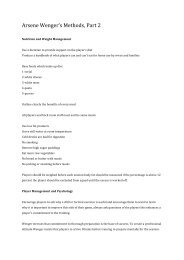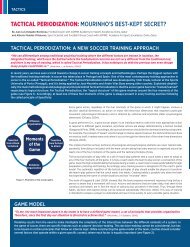Tactical Peroidization.pdf
- No tags were found...
You also want an ePaper? Increase the reach of your titles
YUMPU automatically turns print PDFs into web optimized ePapers that Google loves.
Principle of making tactical principles of play operational<br />
“One of the most difficult questions is to make operational our style of play that by creating exercises where we are able<br />
to embrace all aspects (dimensions), but never forgetting our first concern: to enhance a given principle of play of our<br />
game model.” ( (Mourinho, J. in Gaiteiro, 2006)<br />
A team tends to be attracted to a dynamic behavior that represents its identity and describes a pattern of action. To transform these<br />
patterns into practice, every training exercise must relate to the style of play (game model) and the concept of specificity (see above).<br />
These references should be present in daily work, in order to provide specific adaptations and tactical knowledge. If the proposed<br />
exercise is designed without taking into consideration the style of play, the promoted adaptations can have adverse effects and interfere<br />
with acquisition of the desired knowledge. It is crucial that the exercises represent the way we want to play and the randomness<br />
and unpredictability that the game has. This implies that each of the proposed exercises has to lead to something that players do not<br />
control. If the game is nonlinear, the training exercises, even being less complex, should be nonlinear, excluding any direct cause-effect<br />
relationship. The coach’s intervention plays a key role in conducting the exercise, catalyzing in a positive or negative way its specificity.<br />
It is also important to note that the structural and functional configuration of the exercises is crucial in order to comply with the specificity<br />
of the game. It means that some exercises, because of their structure, promote functionality (e.g., the acquisition of non-conscious<br />
behaviors).<br />
Principle of disassembly and hierarchical organization<br />
of principles of play<br />
“I wrote a document that never is going to be published. It is my training dossier, where I keep all my training guidelines. That<br />
is, all my training goals and the way to achieve them through my methodological principles; ‘to improve these given principles,<br />
these exercises.’ If I should have to name this document, its title would be: ‘The evolution of my training concepts.’<br />
(Mourinho, J. in Lourenço, L. & Ilharco, 2007)<br />
Sub -Sub<br />
Principle:<br />
Changing mental<br />
attitude from attack<br />
to defend<br />
Moment of the Game<br />
Transition from Attack to Defend<br />
Main Principle:<br />
Immediate press to opponent<br />
on the ball and his nearest space<br />
Sub-Principle:<br />
Making the opponent<br />
to play backwards<br />
Figure 4. Example of the Disassemble of a Principle of Play.<br />
(Adapted from Gomes, M. (2006)<br />
Sub-Principle:<br />
Getting compact to<br />
either press the ball or<br />
to get organized to defend<br />
Sub -Sub<br />
Principle:<br />
Communication to<br />
ensure optimal<br />
defensive coverage<br />
Principles of play are complex concepts because they<br />
involve several variables that are related. This is why<br />
<strong>Tactical</strong> Periodization breaks them down to reduce their<br />
complexity. Thus, principles of play are subdivided into<br />
sub-principles, and these are further fragmented into<br />
sub-sub principles. The aim is to make them more understandable<br />
for the players. This process of disassembling<br />
the principles of play has to be done carefully, respecting<br />
the style of play (game model) and the wholeness of<br />
the game (systemic vision). Each specific principle of<br />
the game model is directly related to one of the four<br />
moments of the game (see Figure 4 for an example).<br />
Not an equal value is given to all the principles of play.<br />
Thus, there is a hierarchical organization. The importance<br />
of each principle during the training process is directly<br />
related to the intended game model. Some principles<br />
are more important and valued than others in terms<br />
of what is intended. A coach’s ability to articulate all<br />
the principles that conform to a game model will help<br />
determine the team’s DNA, the coach’s conception of<br />
the game (Tamarit, 2007).<br />
Continued on page 32<br />
31







